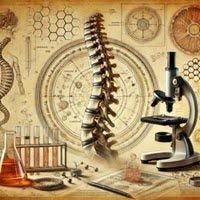Why Chiropractic Works: The Science Behind Spinal Adjustments
and how chiro can help you sleep, chronic pain relief, Key foods for Spinal Health and more!
Discover the benefits of chiropractic, the world's largest natural, drug-free, and surgery-free healthcare system, as more families embrace periodic checkups and adjustments to promote health and healing without relying on drugs or dangerous medical treatments, choosing instead a natural path to achieve and maintain wellness.
TABLE OF CONTENTS
Why Chiropractic Works: The Science Behind Spinal Adjustments
Chiropractic and Better Sleep
Did you know?
Chiropractic and Chronic Pain: A Natural Solution Without Drugs
Essential Oils and Digestive Health: Soothing the Gut Naturally
Bone Broth, Organ Meats, and Raw Dairy: Weston A. Price’s Key Foods for
Spinal Health
Words of Wisdom
Researching Chiropractic
Humor
References
Why Chiropractic Works: The Science Behind Spinal Adjustments
Chiropractic began with a simple yet profound discovery by D.D. Palmer in 1895. He found that restoring movement to a misaligned vertebra in a deaf man's spine improved his hearing. This observation led him to develop the understanding that the nervous system controls every function of the body and that interference along the spine can affect overall well-being (1).
The spine is more than a stack of bones; it protects the spinal cord, which acts as the body's electrical wiring. When a vertebra shifts out of place, even slightly, it can cause nerve irritation. These interferences, which Palmer called subluxations, can disrupt communication between the brain and the rest of the body. By addressing these shifts, chiropractors aim to help the body work as it was designed.
The Nervous System's Role in Health
Every function in the body, from digestion to breathing, depends on the nervous system. The brain sends signals down the spinal cord and through nerves to coordinate movement, immune responses, and emotions. If these signals are blocked or distorted by spinal misalignments, problems can arise.
Many people think of the spine in relation to posture or back discomfort, but its influence extends far beyond that. A misaligned vertebra may affect nerves connected to digestion, breathing, or muscle function. Since the nervous system oversees many processes, interference in one area can lead to effects elsewhere in the body.
The Body's Ability to Self-Heal
D.D. Palmer described chiropractic as working with the body's natural ability to heal rather than forcing change through external means. Health comes from within, and when the body is free from interference, it maintains itself as it was designed to (1).
This idea is simple but powerful: the body is built to heal itself. A cut on the skin closes on its own. A broken bone mends without outside intervention provided the body has what it needs. Chiropractic does not heal—it removes obstacles that prevent the body from working correctly.
Changes That Happen After Spinal Adjustments
People often notice improvements in energy, mobility, and comfort after receiving chiropractic care. Some experience better digestion, clearer thinking, improved sleep, and even enhanced immune function. These changes aren't coincidences. When nerve interference is reduced, the body operates more efficiently.
One common example is the way chiropractic helps infants and children. Many parents bring their newborns to a chiropractor because of colic, feeding difficulties, or trouble sleeping. Birth can be physically demanding, and small misalignments in the spine may contribute to discomfort. By gently adjusting the spine, chiropractors help restore normal nerve function, leading to improvements in well-being.
Athletes also rely on chiropractic to improve performance. When the spine moves properly, muscles coordinate better, reaction times improve, and endurance increases. Many top athletes see chiropractic as essential, not just for recovery but for achieving peak performance.
Chiropractic Respects the Body's Natural Design
Unlike approaches that attempt to mask symptoms, chiropractic works with the body's structure and function. Instead of forcing change, it restores normal movement and alignment, allowing the body to express health naturally.
D.D. Palmer understood that the body is self-regulating. A properly aligned spine reduces stress on the nervous system, allowing the body to function at its highest level. Many people experience noticeable improvements, not because something was "fixed," but because interference was removed, letting the body work as it was meant to.
Palmer's discovery over a century ago was just the beginning of a deeper understanding of how the nervous system controls health. The body's wisdom is already present—chiropractic removes the obstacles that get in its way.
Chiropractic and Better Sleep
A good night's sleep can make all the difference. Waking up refreshed and feeling light and energized isn't just about having the right mattress or bedtime routine. The nervous system plays a key role, and chiropractic care has long been associated with helping the body function as it should—including during rest.
People who struggle with restlessness, tossing and turning, or waking up feeling stiff often find that their spine holds the answer. The body relies on clear communication between the brain and every system that keeps it running. Signals can't travel properly when there's interference—whether from poor posture, stress, or misalignments. This affects more than just comfort; it influences how deeply and peacefully a person sleeps.
It's common to hear from those under regular chiropractic care that they fall asleep faster and wake up less throughout the night. There's a simple reason for this. When the spine is aligned, unnecessary tension eases, and the nervous system shifts away from a state of stress. Many people live with tightness and hardly notice until it's gone. Their shoulders, neck, and lower back relax, allowing the body to settle naturally into rest.
The Nervous System's Role in Sleep
The connection between spinal health and sleep isn't just anecdotal. Research published in Brain Sciences observed significant improvements in light sleep stages among participants receiving chiropractic adjustments over four weeks. These participants also reported enhanced overall quality of life, with notable reductions in anxiety, depression, fatigue, and pain. The study suggests that the health benefits of chiropractic care may be due to altered brain activity, supporting the idea that spinal alignment can ease tension and encourage better sleep (2).
Stress is another factor that affects sleep quality. Many who experience frequent waking during the night or have difficulty falling asleep are unknowingly caught in a cycle of nervous system overstimulation. Chiropractic care is known to support the body's ability to transition from a heightened state of alertness to relaxation. As the nervous system finds balance, the body becomes more receptive to the natural sleep cycle. This is why those receiving regular care often describe feeling more rested, even if the total number of hours slept does not change.
Better sleep isn't just about feeling well-rested. Sleep is when the body repairs itself, restores energy, and processes information from the day. Poor sleep can contribute to brain fog, irritability, and reduced immune function. By improving nervous system function, chiropractic care may help people sleep more soundly and wake up feeling clearer and more focused. Over time, consistent rest can have long-term benefits for physical and mental well-being.
Light pressure, gentle care, and attention to the body's natural structure often lead to noticeable differences. Some notice it right away, others over time. Either way, sleep improves when the body isn't working against itself.
Did you know?
The first St. Patrick's Day parade didn't happen in Ireland? it was held in New York City in 1762 by Irish soldiers in the British army.
More than 13 million pints of Guinness are consumed worldwide on St. Patrick's Day, making it one of the biggest beer-drinking holidays.
Chiropractic and Chronic Pain: A Natural Solution Without Drugs
The Spine and Chronic Pain
Chronic pain can wear a person down, draining energy and making daily life difficult. Many people turn to medications for relief, only to find themselves relying on them long-term without addressing the real issue. Chiropractic offers another way—one that works with the body rather than against it.
The spine isn't just a stack of bones; it protects the nervous system, the body's communication network. When the spine is misaligned, nerves can become irritated, leading to pain that may not go away on its own. This isn't limited to backaches—headaches, joint pain, and even arm or leg discomfort may all stem from spinal issues. Restoring proper alignment allows the body to function as it was designed, relieving pain naturally.
A Different Approach to Healing
Many who come to a chiropractor have tried everything else. Take, for example, a man in his 40s who had lived with lower back pain for years. He had tried stretching, heat, and over-the-counter medications. Nothing made a lasting difference. After a few visits to the chiropractor, he noticed something unusual—his pain wasn't coming back. His body had found its way back to normal function without artificial interference.
The body wants to heal, and removing interference gives it the chance to do so. Chiropractic does not force anything; it simply restores what was already there. This approach has helped countless people find relief without relying on outside substances. A study published in the Journal of Manipulative and Physiological Therapeutics found that those who received chiropractic adjustments for chronic lower back pain had better long-term outcomes than those who used medication alone. (3)
Restoring Natural Function
The best part? This is not a one-size-fits-all process. Every person's spine tells a different story, and a skilled chiropractor listens to it. Some notice an immediate difference, while others improve gradually. Either way, the goal remains the same: helping the body work as it should.
Chronic pain is not something to accept as a way of life. The body is capable of far more than most people realize. Chiropractic provides a way to unlock that potential—naturally, safely, and effectively.
Essential Oils and Digestive Health: Soothing the Gut Naturally
Peppermint Oil: Cooling Relief for Digestion
Peppermint oil is known for its refreshing scent and cooling effect. When diluted and massaged onto the abdomen, it can help relax the digestive tract muscles, making it useful for bloating and cramping. Many people also inhale peppermint oil to ease nausea, especially during travel or after eating a heavy meal. Research suggests that peppermint may support gastrointestinal comfort, with a study by McKay and Blumberg (2006) highlighting its potential benefits (4).
Ginger Oil: Warming Comfort for the Stomach
Ginger has long been used to settle the stomach, and its essential oil offers similar benefits in a concentrated form. When mixed with a carrier oil and applied to the abdomen, ginger oil provides a warming sensation that can encourage smoother digestion. Some prefer to add a small drop to warm tea or water, mimicking the traditional use of ginger root for digestive support. This oil is often chosen for its ability to ease queasiness and promote overall stomach comfort.
Fennel Oil: Supporting Gut Function
Fennel oil, with its naturally sweet and earthy scent, is often used when digestion feels sluggish. It can be diluted and rubbed onto the abdomen to encourage digestive ease. Fennel seeds have been chewed after meals for centuries, and their essential oil provides a concentrated form of the same beneficial compounds. Many find fennel oil helpful in maintaining regular digestion and soothing occasional bloating.
Using Essential Oils Safely
With essential oils, a little goes a long way. Proper dilution is key, as applying them directly to the skin without a carrier oil may cause irritation. High-quality, pure oils offer the best experience, whether applied topically, inhaled, or used in appropriate amounts in warm liquids.
A Natural Way to Soothe Digestion
Essential oils like peppermint, ginger, and fennel offer a simple and effective option for those seeking natural digestive support. These plant-based solutions have stood the test of time, whether easing bloating, reducing nausea, or promoting gut comfort.
Bone Broth, Organ Meats, and Raw Dairy: Weston A. Price’s Key Foods for Spinal Health
Dr. Weston A. Price, a dentist and researcher, spent years studying the diets of traditional societies. He found that people who ate nutrient-rich, ancestral foods had excellent bone structure, strong teeth, and resilient joints. Among the foods he highlighted for spinal health were bone broth, organ meats, and raw dairy. These foods provide essential nutrients that modern diets often lack. (5)
Bone Broth: Building Strong Vertebrae and Joints
Bone broth has been a staple in traditional diets for generations. When animal bones simmer for hours, they release collagen, gelatin, and an array of minerals, including calcium, magnesium, and phosphorus. These nutrients help maintain strong vertebrae and keep spinal discs flexible.
Collagen and gelatin support connective tissues, including the ligaments and cartilage surrounding the spine. Many who consume bone broth regularly report improved mobility and reduced stiffness, as the broth nourishes joints from within. The easily absorbed minerals in broth also provide the raw materials needed for bone maintenance and repair.
Organ Meats: A Lost Superfood for Spinal Health
Organ meats, once prized for their exceptional nutrient content, have largely disappeared from modern diets. However, they remain one of the best sources of vitamins and minerals essential for spinal strength.
Liver is particularly rich in vitamin A, which supports calcium absorption and bone remodeling. It also contains vitamin K2, a nutrient that ensures calcium is properly deposited in bones rather than soft tissues. Without adequate K2, calcium can accumulate in arteries and joints instead of strengthening the spine. Heart and kidneys also contain important nutrients like CoQ10 and B vitamins, which help maintain energy levels and overall musculoskeletal health.
Raw Dairy: Calcium and Beyond
Raw dairy was a dietary cornerstone in many traditional cultures, providing bioavailable calcium, vitamin D, and healthy fats. Unlike pasteurized dairy, raw milk preserves natural enzymes and beneficial bacteria that aid digestion and nutrient absorption.
The calcium and phosphorus in raw dairy are critical for maintaining spinal strength, while vitamin D helps regulate calcium levels in the body. Many people who consume raw dairy notice improvements in posture, muscle tone, and skeletal resilience, as these nutrients work together to support the body's natural structure.
Traditional Foods for a Stronger Spine
Weston A. Price's research continues to be relevant today. While processed foods dominate modern diets, traditional nourishment provides the essential building blocks for spinal health. Bone broth, organ meats, and raw dairy offer a natural way to support the spine, improve flexibility, and maintain long-term strength. Those who return to these foods often experience better mobility, increased comfort, and a greater sense of vitality.
Words of Wisdom
"The best luck of all is the luck you make." - Douglas MacArthur
"A kind heart brings its own good fortune." - Irish Saying
Researching Chiropractic
Chiropractic clinical case histories have been a regular feature of our patient newsletter since its inception. There seems to be no limit to the health problems that respond positively to chiropractic care. How many people suffering, reliant on medication and drugs, and facing a life of limitation could be helped by chiropractic care?
Probably most of them.
Linda, a 55-year-old schoolteacher, struggled with severe low back pain that made it difficult to stand in front of her class. Painkillers provided little relief, and her orthopedic doctor suggested surgery.
Looking for alternatives, she tried chiropractic care. Her chiropractor discovered a pelvic misalignment, likely from years of poor posture. After just a few sessions, Linda felt significant relief, and after three months of treatment, she was able to teach pain-free for the first time in years. She even canceled her surgery, making her skeptical orthopedic surgeon admit, "Whatever you're doing, it's working."(6)
Tom, a 35-year-old firefighter, frequently battled colds and sinus infections due to his demanding job. Skeptical but willing, he joined a chiropractic study. After months of adjustments, he noticed fewer illnesses, milder allergies, and more energy. One night, after a major fire, he realized he hadn't been sick in months. Lab tests confirmed improved immune markers, reinforcing his belief in chiropractic care's benefits.(7)
Humor
I told my doctor I broke my arm in two places.
He said, "Well, maybe stay out of those places!"
My fitness tracker just told me I burned 500 calories...
Turns out I left it in the dryer.
Trainer: "Do you want to work on strength or endurance?"
Me: "I just want to work on surviving this workout."
I started taking vitamins...
Mostly because chewing the gummy ones feels like a snack.
Bye
Please write or stop by and give us your feedback. Are there any subjects you'd like to hear about? Anything you dislike? Feedback is always important to us. And, of course, if you'd like hard copies of this newsletter, stop by the office, and we'll give you some for your friends and relatives. If they have email, have them write to us, and we'll add them to our subscriber list.






Hi doc! Love your Substack. I am currently in chiro school down at BCC. The clinical examples with patients and their great outcomes are very inspiring and keeping my chiropractic fire lit 🙏. Always feel free to share more of them 😊. Much love, Jordy